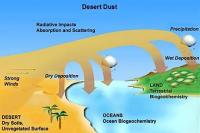- Use environmental data and themes to help your students apply mathematics to real-world problems. Assign environmentally-themed math problems, analyze data such as population figures, land use statistics, and pollutant levels, use data to draw inferences about changes in population and natural resource consumption, and have students explain the impacts of their analysis. Use the search function to the right to explore other ways to use environmental data in your classroom.
- StoryPosted bycgray3onFebruary 1, 2011
The amount of dust in the Earth's atmosphere has doubled over the last century, according to a new study; and the dramatic increase is influencing climate and ecology around the world.
Posted in: - ResourcePosted byAnonymousonMarch 24, 2010
In this lesson, students discover water and energy connections by learning how sources of energy require substantial amounts of water and how energy is used in the process of providing tap water to millions of homes.
Posted in:
Latest in this Subject
View more News, Resources , Professional Development, Grants, Success Stories
- ResourcePosted bycaitlineonJuly 6, 2011
Deep Earth Academy, developed by the Consortium for Ocean Leadership, is a website that facilitates and developes programs and materials based on scientific ocean drilling expeditions and Earth Systems Science to strengthen students' science, mathematics and analytical skills.
View resource - ResourcePosted bymedudaonJuly 6, 2011
The NCSE-NASA Interdisciplinary Climate Change Education Team is developing a curricular package on climate change based on a University of California Davis course taught by Professor Arnold Bloom. The curriculum includes modules that cover a wide range of topics relevant to climate change.
- ResourcePosted bycaitlineonJuly 5, 2011
This printable activity book, developed by Natural Resources Canada's Office of Energy Efficiency, includes ten activities on energy use and conservation, including crossword puzzles, a Green Audit, brainstorming activities and simple calculations. Although written for a Canadian audience, the information is useful for American students, as well.
- ResourcePosted bycaitlineonJuly 5, 2011
In this lesson, students will learn about the various parts of a tree trunk. Students will then build a tree trunk with all of its parts and make an art project covered with pseudo veneer. This lesson is best suited for grades 5-8 and adheres to Pennsylvania State Science Standards.
- ResourcePosted bycaitlineonJuly 5, 2011
These lab activities, developed by the US Forest Service, are supplemental activities for grades K-12 that can be used in any science or interdisciplinary class. The guide includes hands-on, data gathering laboratory exercises, as well as games, quizzes and a glossary of additional resources. The activities may be adapted to meet content standards in math and science.
View resource
Do you know of a resource that you think other teachers should know about?
Share your resource!



